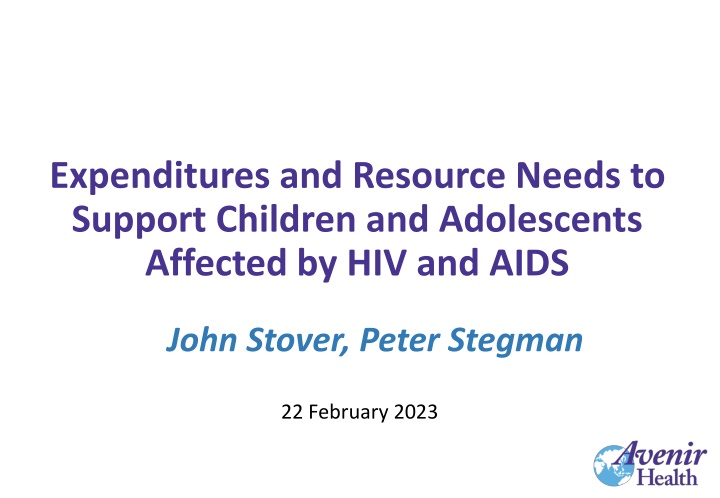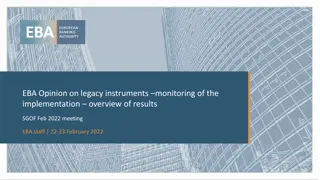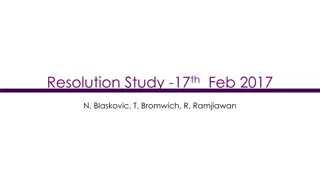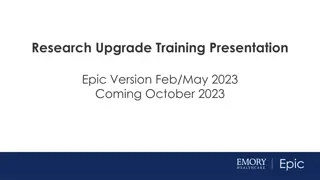
Expenditures and Resource Needs for Children and Adolescents Affected by HIV/AIDS
Explore current expenditures on programs for children and adolescents impacted by HIV/AIDS, assess the funding sources, and compare them to estimated resource requirements. Understand the challenges in tracking expenditures and funding distribution from various global health organizations. Analyze the financial landscape to support better resource allocation for the targeted population.
Download Presentation

Please find below an Image/Link to download the presentation.
The content on the website is provided AS IS for your information and personal use only. It may not be sold, licensed, or shared on other websites without obtaining consent from the author. If you encounter any issues during the download, it is possible that the publisher has removed the file from their server.
You are allowed to download the files provided on this website for personal or commercial use, subject to the condition that they are used lawfully. All files are the property of their respective owners.
The content on the website is provided AS IS for your information and personal use only. It may not be sold, licensed, or shared on other websites without obtaining consent from the author.
E N D
Presentation Transcript
Expenditures and Resource Needs to Support Children and Adolescents Affected by HIV and AIDS John Stover, Peter Stegman 22 February 2023
Purpose Understand current expenditures on programs for children and adolescents affected by HIV/AIDS Describe the sources of expenditures Compare to estimates of the resources needed
How much is currently spent How much is currently spent on programs for children and on programs for children and adolescents? adolescents? 3
Public expenditure databases do not provide comprehensive picture PEPFAR reports expenditures on its Panorama Spotlight Dashboard, but the categories are too broad to identify all spending on children and adolescents. PEPFAR has prepared estimates drawn from budgets and agreed allocation rules Global Fund only reports in very broad categories. The current reporting system does not support analysis by intervention. 4
PEPFAR COP 21 Program Budget (0-24) (US$ Millions) Above site programming, $56 Management, $114 Care and treatment, $321 Total 0-24 = $1210 million Total 0-17 = $818 million PMTCT, $170 Testing, $62 Orphans and vulnerable children, $204 Prevention, $186 Socioeconomic, $97 5 PEPFAR Panorama Spotlight (https://data.pepfar.gov/library, Financial Management, Children and Adolescent Budget
UNAIDS Spending Assessments UNAIDS supports the collection of detailed expenditure information using a national health accounts approach to HIV/AIDS expenditures (National AIDS Spending Assessment NASA). Over 100 countries have implemented NASA or provided their own data Limitations: Not all countries report in all years. Full NASAs are usually done only every 5 years. Spending on social enablers and social protection may not be classified as AIDS expenditures Source: https://hivfinancial.unaids.org/hivfinancialdashboards.html 6
Current Expenditures for Children and Adolescents in LMIC $2.0 $1.8 PM $1.6 Program management Expenditures (Billions of US$) ASL Above site level costs $1.4 Children and adolescents C&A $1.2 Social protection OVC Key populations $1.0 VMMC $0.8 VMMC PrEP for AGYW Cash transfers for AGYW $0.6 ART Pediatric ART $0.4 PMTCT PMTCT $0.2 $0.0 Estimated Expenditures in 2020 Resource Needs to Achieve Global Targets AGYW = adolescent girls and young women, ABYM = adolescent boys and young men, STI Tx = treatment of sexually transmitted infections, CSE = comprehensive sexuality education, EE = economic empowerment, VMMC = voluntary medical male circumcision, PMTCT = prevention of mother-to-child transmission, C&A = children and adolescent not disaggregated, ASL = above site level, PM = program management
Distribution of Spending by Source Other multilateral donors 2% Other bi-lateral donors 2% Other sources 1% Global Fund: Other 6% Global Fund: PEPFAR 3% National governments 46% PEPFAR 36% Private (households, NGOs, corporationts) 4% Source: UNAIDS GARPR16-GAM2021Oct2021
Distribution of Spending by Intervention Children and adolescents 6% PMTCT 23% Social protection 25% Early infant diagnosis 2% Key populations 6% Pediatric ART 23% VMMC 15% PrEP for AGYW 0% Cash transfers for AGYW 0% Source: UNAIDS GARPR16-GAM2021Oct2021
Distribution of Spending by Country Rest of World South Africa Zambia Haiti India Rwanda C te d'Ivoire Brazil Swaziland Ethiopia Thailand Kenya Nigeria Zimbabwe Botswana Namibia Mexico Malawi Uganda Mozambique Russian Federation Source: UNAIDS GARPR16-GAM2021Oct2021
Distribution of Spending by Income Group $700 Millions $600 Children and adolescents $500 Key Pops SocialProtection $400 EID CashTransfers $300 PrEP_AGYW $200 VMMC PMTCT $100 PedART $0 Low income Lower middle income Upper middle income 11
How much funding is How much funding is needed? needed? 12
Estimated Resource Needs UNAIDS Global AIDS Strategy 2021-2026 Establishes targets for 2025 and 2030 for all LMIC by service Resources needed = People in need of service x Coverage x Unit cost 13
Current Expenditures in LMIC $3.0 $2.5 Program management Resource Needs (Billions of US$) Above site level costs Children and adolescents $2.0 Social protection Key populations $1.5 VMMC PrEP for AGYW Cash transfers for AGYW $1.0 Pediatric ART EID $0.5 PMTCT $0.0 Estimated Expenditures in 2020 Resource Needs to Achieve Global Targets AGYW = adolescent girls and young women, ABYM = adolescent boys and young men, STI Tx = treatment of sexually transmitted infections, CSE = comprehensive sexuality education, EE = economic empowerment, VMMC = voluntary medical male circumcision, PMTCT = prevention of mother-to-child transmission, ASL = above site level, PM = program management
Is there a funding gap? Is there a funding gap? 15
ART, PMTCT, EID, VMMC Coverage 100% Clear coverage gap Additional $160M needed to meet targets at average unit costs Funding is not the only barrier. There are also health system constraints, demand limitations, difficulties to identify all PLHIV 90% 80% 70% 60% 50% 40% 30% 20% 10% 0% PMTCT EID ART (0-14) ART (15-17) VMMC 2021 Target 16
Key Populations Coverage 100% Clear coverage gap Additional $410M needed to meet targets at average unit costs Information on 15 17 age group is limited Other issues: political will, legal barriers, stigma and discrimination 90% 80% 70% 60% 50% 40% 30% 20% 10% 0% FSW MSM TG PWID 2021 Target Source: aidsinfo.unaids.org, UNAIDS Global Strategy 2021-2026 17
For some services it is hard to quantify the need Services Social protection and services of orphans and vulnerable children Programs for AGYW (DREAMS) Issues People in need are determined locally No clear packages of services required by each population Global need has been estimated Children and adolescents clearly benefit but it is difficult to assign a proportion of total resource need to them Societal enablers Reduce stigma and discrimination Legal reform / decriminalization Prevent gender-based violence 18
Conclusions Current expenditures on programs for children and adolescents affected by AIDS are about 12% of total expenditures Coverage is high for some key services but still short of global targets Additional expenditures will be needed to meet targets, but other constraints also need to be addressed to benefit from additional funding For some interventions need is not easily estimated at a global level















